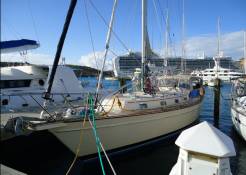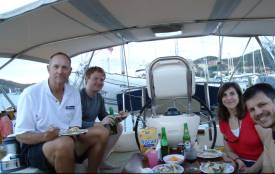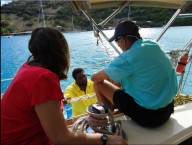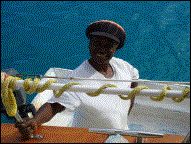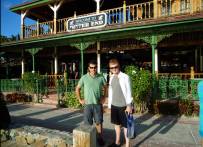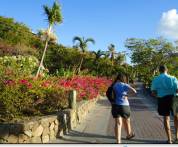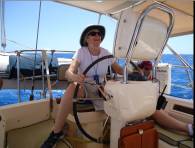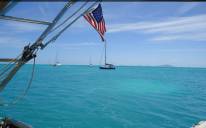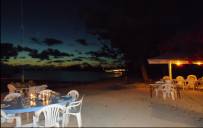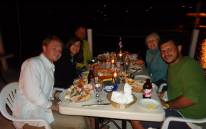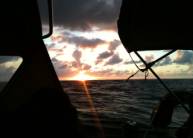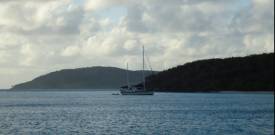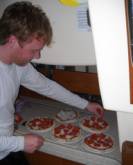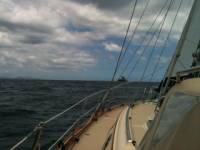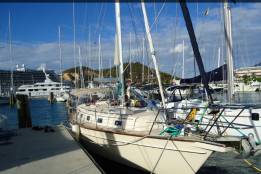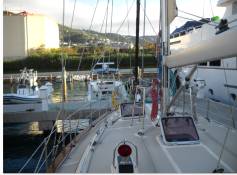|
|
2011 Caribbean Cruises |
| Home
Purpose Course Descriptions School Yachts Schedule of Courses Ocean Training Cruises ASA Certification Registration Info Our Location Our People Contact Us |
14-16 Mar:
Captain completes several minor maintenance issues left over from his just
completed ASA101-104 course and is ready for the arrival of the crew by the
afternoon of 16 March. All arrive
looking forward to spending time on the water and expanding their sailing
skills. Dan arrived early and spent
the last day SCUBA diving around St Thomas.
He arrives a little water logged but ready to go.
We have two Brits with us. Angela,
though a long time resident of the US, still has a very British accent, and
Carolyn who has been in the US since 2002.
Tea and teatime take on a new meaning with this crew.
After stowing gear and initial boat orientation, we head up to Tickles,
the dockside restaurant, for dinner and start getting to know each other. Each
member of the crew brings a wealth of sailing experience – all are racers with
cruising background – that we will seek to share and build upon.
Following dinner, we return to the boat and start developing a cruise
plan and associated meal plan. Day 1: Thur, 17 Mar: All up early and ready to start by 0830. We finalize our cruising plan and complete our inventory of onboard stores before finalizing our provisioning list. The Captain, Charlie and Carolyn head to Pueblo, the local market, for provisions while Dan and Angela check out the boat to find required/recommended safety equipment and to get familiar with boat storage and equipment locations. After stowing provisions, we review the ASA course requirements, check personal safety equipment and go over key sections of the Mdschool course “Blue Book” – a great source of information for passage preparation. We focus on operating procedures, safety, nighttime navigation and boat systems. Following lunch, we spend time on deck inspecting the standing and running rigging, rig the storm trisail and disassemble/assemble the port side genoa winch. We find the inboard end of the whisker pole is bent so we secure the pole. After our ondeck orientation we go below to finish reviewing ship systems. While checking the fluid level in the transmission, the screw for the transmission dipstick breaks in half. Pre departure equipment inspection is critical when cruising. Better to find and correct maintenance issues before leaving the dock then having to do so underway. Dinner on board gives everyone a chance to get used to cooking in the galley but it’s also St Patrick’s Day, so after dinner, several of the crew head up to Tickles to enjoy the wild and crazy St Pat’s celebration.
Day 2: Fri, 18 Mar: Final departure preparations include finding a replacement for the dipstick. No direct replacement is at hand so after discussions over the phone, and with folks at the local chandlery, we improvise a temporary replacement. After topping off our water and securing all lines, we depart our slip heading to Jost van Dyke and the BVI. The wind is light and variable so we motor sail along the south side of St Thomas, thru the Current Cut and into Pillsbury Sound where we secure the engine and sail up toward Jost van Dyke, a port of entry into the BVI. We pick up a mooring in Great Harbor, go ashore to clear customs and pay a short visit to Foxies to experience the local color and get a cool drink. Back
to the boat and off to Little Harbor where we find a secure mooring and are
immediately entertained by “salesmen” from Sidney’s Peace and Love and
Harris’ restaurants. Each vie for
our evening dinner attentions. Negotiating the best deal falls to Carolyn who
has been here before and is one of two birthday celebrants on board.
She drives a hard bargain with both but finally decides on Sidney’s.
We have time for a short swim and make dinner reservations over the
radio. We also find our temporary
fix for the transmission dipstick is not working as well as hoped and work with
Lee Tucker, a seasoned school instructor who has a similar boat, to find a
replacement. This will require a detour back to Red Hook on the east end of St
Thomas in the morning. Tonight we
enjoy a truly great meal at Sidney’s, a quiet night on a mooring and a star
filled sky, each thankful we are not at home in the cold.
Day
3: Sat, 19 Mar:
Up and ready for an early departure after a
windless night. Our goal for today is
retrace our steps to Red Hook, pick up a replacement for the dipstick, then head
NE to Virgin Gorda. Lee has
arranged for us to pick up the replacement from Island Marine.
Flexibility is a key to successful cruising and Charlie, our navigator
for today, has his work cut out for him. He
had initially laid out a course along the north side of Tortola to North Sound
on Virgin Gorda. Now he has to
reset and take us back across Pillsbury Sound, into a new port, then back east
along the south side of Tortola and approach North Sound from the south and not
north. He does a great job – lots
of opportunity for plotting practice. Light
wind forces us to motor sail into Red Hook, a very busy and crowded port.
We pick up a mooring and Dan and the Capt head ashore to get the
replacement part. In short order we
are back and soon ready to get underway for what turns out to be a long motor
sail to Virgin Gorda. Winds vary throughout the
day but always from the NE. We
review ASA106 course material, confirm our progress by taking two-bearing fixes
and reinforce our understanding of the “rules of the road”.
We also get familiar with the chart plotter and how to access the data
the Automatic Information System (AIS) provides on boats in the area. Good prep
for our forthcoming overnight trip. Into
North Sound and at a mooring off Vixon Point by 1500– the end of a 40+ mile
day. The anchorage is a little
rolly but secure, and provides a great view of the finish line of a “big”
boat race based out of the Bitter End Yacht Club.
After a short stop to secure and clean up the boat, we head over to the
Bitter End Yacht Club by dingy to explore the area. Later we go over to the
small but impressive Saba Rock for dinner.
Dinner is good but not quite “up to par” with our meal at Sidney’s.
Lots of activity and a very interesting array of boats all around us.
We return to the boat under a beautiful full moon and plan our trip north
to Anegada.
Day 4: Sun, 20 Mar: Departed North Sound after a very rolly night. The wind has backed to the NNE and is blowing 15-25 knots. Numerous overnight rain showers give way to a clear day to start our trip to this low lying island. We motor out of the sound into large waves and ocean swell and find no real lee behind Necker Island to practice MOB under sail so we beat to the north till 1130, then resort to motoring the last several miles. Charlie as Captain and Angela as Navigator carefully track our progress and find the entrance buoys close to where the chart plotter shows them. They are far enough off that it underscores the requirement to never rely on a single source of navigation information. Charlie has us secured to a mooring off the Anegada Reef Hotel by 1400 – an almost surreal location – a very low lying island with bright white sand, turquoise water and wind blowing all around us. The
afternoon is spent reviewing ASA106 topics, planning our overnight passage and
helping another boat recover their dingy – important to keep your dingy
attached to boat when the nearest lee shore is 20 miles away.
After a beautiful sunset, we head ashore for a truly great lobster dinner
at the hotel. Although expensive, they do a very nice job of presentation and
service. Angela meets the owner’s
wife who is also English. Turns out
the two of them grew up less than 100 miles from each other – small world.
After dinner, it’s back to the boat to put the final touches on our
passage plan and settle in for a restful night – this time without passing
showers.
Day 5/6: Mon/Tues, 21-22 Mar: Based on the weather forecast of light winds from
the NNE clocking to the ENE we decide to sail south thru the Necker Passage and
toward St Croix. Our cruise plan
includes a decision point that, based on conditions, we can go north or south of
St Croix toward our final destination of Culebra in the Spanish VI.
Dan and Carolyn, our navigators for the next two days, layout our course,
identify lights to be used for navigation and potential danger areas, and
calculate the tide for our arrival at Culebra.
After a late pancake breakfast prepared by the Captain, we rig lee cloths
and the boom preventer, secure equipment to include securing the dingy on the
davits, prepare lunch and get a final check on the weather.
After clearing the entrance channel, we practice MOB under sail in light
but gusting winds before continuing on our course to the south.
The sail south is without
incident, rotating helmsmen, taking fixes to confirm position, and being
refreshed by passing rain showers. Before
nightfall we decide to take the longer route and pass south of St Croix.
Overnight the winds are up and down reaching 25 knots at times with
significant wind shifts but our pre reefed sails keep the boat under good
control. Around 0400 we conduct a
nighttime MOB drill under sail. The experience underscores the importance of not falling
overboard – prevention is better that reaction. We make contact with several
ships over VHF that AIS indicates will pass close by to ensure safe passage and
round the western end of St Croix as the sun begins to raise.
It turns into a beautiful, clear morning.
A fresh wind and close reach carry us north toward Culebra and port of
entry at Dewey. The entrance to Culerbra is
guarded by many reefs but our navigator Carolyn, assisted by the crew, find the
entrance channel and Angela brings us into a safe anchorage off the town dock.
We contact US Homeland Security over the phone for clearance and are
later told we need to present ourselves at the town dock to have our papers
inspected. The dingy is lowered and
we head ashore to complete our clearance back into the US.
While secure, the anchorage is very windy, so we decide to head over to
the nearby island of Culebrita. We
carefully retrace our steps to clear the harbor and then head north toward what
turns out to be a beautiful and very peaceful anchorage.
We pick up one of several moorings in the lee of the island but in a
position to see the large seas running just to our east.
Though tired from our trip, we can’t pass up a swim in the beautiful
waters. Charlie makes dinner – a
real treat of personal pizzas - and we settle in for an early bedtime, confident
in the knowledge that our 145 nm overnight passage has given us new skills to be
further developed and utilized.
Day 7: Wed, 23 Mar: A quiet night with only one other boat in the anchorage. From our secure mooring we can hear the wind blowing and waves breaking a short distance way. After a short review of plotting techniques and marine weather, we depart for our final night in Brewers Bay and the highlight of the trip – the ASA106 written exam. Winds clock to the ENE and rise and fall all during the day. As we approach Sail Rock, the frequent wind shifts provide us the opportunity to see this interesting geological formation from close quarters and from every side. We finally secure the sails and motor into Brewers Bay, an excellent anchorage with good protection from wind and waves. On the way over, we hold an informal contest between helms persons to see who can achieve the highest speed. It’s close between Angela and Carolyn with 7.20 knots each. After a quick review of the test material, the crew
settles in for the ASA106 test while the Captain prepares a spaghetti dinner.
After dinner we review the test, which all pass, and discuss the events of the
last several days. All agree that
the longer course around St Croix was the way to go, giving them more time
underway. The day’s events are
not quite complete. After dark, a
cruising catamaran enters the anchorage and decides to anchor close by.
We hail him and indicate the close proximity to our boat and anchor and
the need for us to be up and underway early the next day.
He acknowledges the situation but does not move; prompting a discussion
on the roles and responsibilities for an anchor watch – always opportunities
to learn. No watch required but we do keep an eye out during the night.
Day 8: Thurs, 24 Mar:
Capt. Steve Runals |
Web site design by F. Hayden Designs, Inc.
